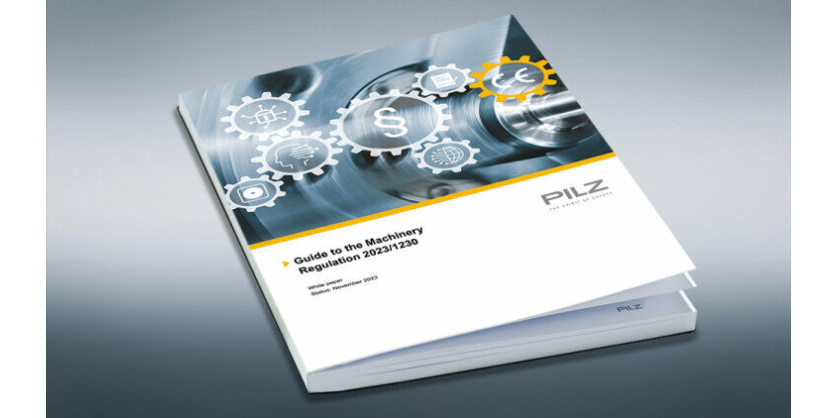EU Machinery Regulation 2023/1230
Pilz Explains: Which requirements apply for manufacturers of machinery?
January 11, 2024

The Machinery Regulation replaces the Machinery Directive
The EU Machinery Regulation will apply from 20 January 2027. It came into force in all member states on 19 July 2023, twenty days after it was published in the Official Journal of the European Union. Machine manufacturers now have time in which to meet the new safety requirements on plant and machinery.
Check the changes that affect you. The Guide to the Machinery Regulation will help you with this. Find out what’s changing, what’s important and what needs to be done. Everything in one document!
Guide to the Machinery Regulation
What is in force until application of the Machinery Regulation becomes mandatory?
The Machinery Directive (2006/42/EC) is the current and final version of the Machinery Directive. Application has been mandatory in the EU since 2009. It is aimed primarily at manufacturers and requires safety to be guaranteed when human and machine interact. If you compare the automation and engineering of today with the technical requirements of 15 years ago, it is clear that the revision of the Directive was more than sensible. Digitisation and networking, as well as the new related issues of Industrial Security and Artificial Intelligence (AI), are in the process of significantly changing factory halls and the plant and machinery within them.
The new Machinery Regulation aspires to maintain the high level of safety that was achieved with the implementation of the specifications from the Machinery Directive. This means that you must meet all the specifications of the new Machinery Regulation in your company within the transitional period. Information and implementation of the specifications of the new regulation in terms of risk analysis, instructions for use and technical documentation, as well as conformity assessment and declaration of conformity with subsequent CE marking, mean that companies face an enormous challenge.
This is the official title of the Machinery Regulation: Regulation (EU) 2023/1230 of the European Parliament and of the Council on machinery.

Why do we have the Machinery Regulation?
The birth of modern machinery safety as we know it today dates back less than 40 years: in 1989, the change was brought about with the Machinery Directive. Since then, machinery safety has been mandatory in Europe. Its provisions have consistently been brought in line with technical developments. The aim has always been to design safe interaction between human and machine, and to promote the standardization of fundamental and mandatory European machinery safety requirements. Publication of the EU Machinery Regulation 2023/1230 in the Official Journal of the EU on 29 June 2023 has brought the specifications up to the current state of the art. The EU Machinery Regulation becomes legally binding in all EU states on 20 January 2027 (key date regulation).
The EU Machinery Regulation – what are the changes?
The new regulation continues to cover machinery and related products, but safety components now also include software. It provides greater clarity as to when there is a substantial modification to existing plant and machinery, and therefore a new CE conformity assessment must be conducted. What’s more, it also takes into account the growing importance of Industrial Security and digitisation.
Industrial Security is a mandatory element for the safety of machinery, and no longer open to the interpretation of those placing the machine on the market. Manufacturers will need to draw up appropriate Industrial Security concepts.In this respect, Industrial Security is one of the main themes of the Machinery Regulation. Manufacturers of networked machinery should prepare well in this regard. They will also face demands from other areas of legislation (e.g. Cyber Resilience Act, Radio Equipment Directive).
Overview of the most important changes

Machines subject to inspection
The list of machines subject to inspection, which was previously in Annex IV of the Machinery Directive 2006/42/EC, has “moved” to Annex I. In Section A it contains a list of high-risk machines, for which mandatory inspection and certification through a third party is required. In future, six machine categories will be subject to inspection; application of a harmonized standard does not remove the inspection obligation. This is due to the current developments in Artificial Intelligence. For the six listed product groups, machine manufacturers can no longer self-declare compliance in conjunction with a harmonized standard, as previously. Instead, a named accreditation body must be involved.
Substantial modification
The regulation has been extended to include a definition of a substantial modification of machinery and the legal consequences of such a modification. A conformity assessment procedure is required for machinery safety if a machine undergoes major modifications or when changes are made that affect the machine’s compliance with the statutory provisions for CE marking. If a substantial modification has taken place, the operator becomes the manufacturer – with all the obligations that entails.
Safety components
The definition of safety components now includes not only physical, digital and/or mixed-type components, but also software.
New digital technologies
The emergence of new digital technologies such as Artificial Intelligence, the Internet of Things and robotics present new challenges for product safety. The regulation covers the safety risks arising from new digital technologies.
Cybersecurity
In a new section entitled “Protection against corruption”, the Machinery Regulation now also establishes requirements for the cybersecurity of machinery. Cybersecurity threats must not be allowed to compromise the machine’s safety functions. Manufacturers must review their existing safety concepts in this regard!
Digital instructions
Manufacturers shall be allowed to supply instructions in digital form. Should the customer request it, the manufacturer must supply the instructions in paper format. The EU Declaration of Conformity can also be provided in digital form. Partly completed machinery can be delivered with digital assembly instructions as well as with a digital Declaration of Incorporation.
What does the new Machinery Regulation mean for harmonized standards?

It is still unclear how the process will run with the existing harmonized standards under the Machinery Directive. As it currently stands, these will need to be relisted. With over 750 directly listed standards alone, that means a significant effort over several years. With a defined transition period of 42 months, the standards committees now have a lot of work ahead of them. It will be interesting to see whether the relevant standards will be available as harmonized standards by the time the EU Machinery Regulation comes into force – on 20 January 2027. For this case, the Machinery Regulation leaves the door open to authorities to issue special transitional provisions. Pilz will keep an eye on the ball for you!
Machine manufacturers are not alone
Pilz has supported you as a machine manufacturer for years, with a comprehensive package of machinery safety services – from safety analysis to validation and CE marking. Experts from Pilz will advise you in the case of a substantial modification to plant and machinery in accordance with the requirements of the Machinery Regulation. Pilz also has the new normative security requirements in its sights – because Industrial Security ensures the integrity of safety at the machine. This is why the company has added relevant training in Industrial Security to its services package.

More Information
EU Publication
The Machinery Regulation was published in the Official Journal of the European Union on 29 June 2023. You will find the official document here.
Related Story
Pilz Digital Annual Press Conference 2023 – Safety, Security and Automation
Pilz recently presented their annual press conference where the Board of Directors outlined the past 2022 business year and provided an outlook on further economic and technological development within the Pilz Group. 2022 was a disruptive year for many companies, and Pilz was not immune to the effects of world events such as the war in Ukraine, the COVID pandemic, natural disasters, and supply chain disruptions. Yet, despite all these external factors, Pilz managed to make the most of these adverse and imponderable economic conditions.

